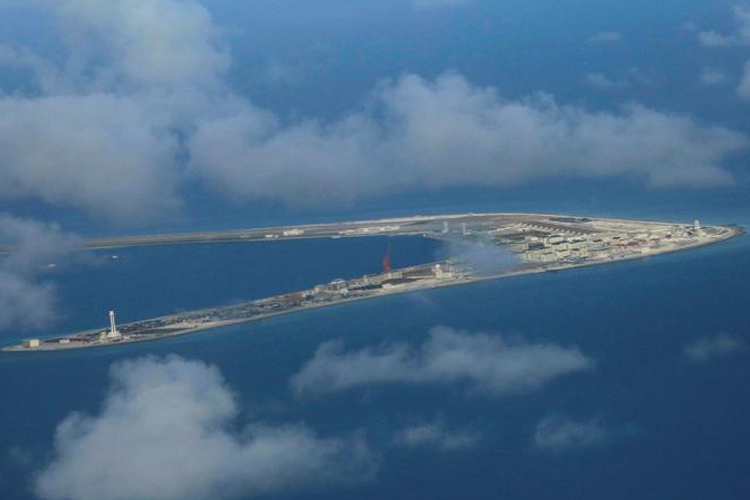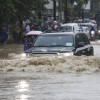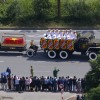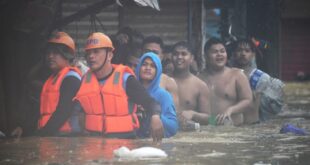China completing militarization of some islands in the East Sea (South China Sea), violating sovereignty of other nations, reveals its intention to further intimidate other claimants, experts say.
 |
|
An aerial view of Subi Reef illegally occupied by China, April 21, 2017. Photo by Reuters/Francis Malasig |
On March 22, U.S. Indo-Pacific commander Adm. John Aquilino said China has fully militarized at least three of several artificial islands it has built in the South China Sea, arming them with anti-ship and anti-aircraft missile systems, laser and jamming equipment as well as fighter jets, AP reported.
Professor Harsh Pant of the Observer Research Foundation, an independent global think tank based in Delhi, India, said China’s move was a continuation of the desire to enhance its consolidation over the South China Sea.
“Beijing is making it clear that it has no interest in diplomatically resolving this issue (disputes with other countries). Instead, its approach is to create new realities on the ground so that other nations will have no option but to acquiesce to it.”
Gregory Poling of the Center for Strategic and International Studies (CSIS), a U.S. think tank, said militarization of Spratly Islands bases has been a steady development by China, not a new development or something with a clear end point.
According to Carlyle Thayer, emeritus professor, University of New South Wales Canberra at the Australian Defense Force Academy, China’s militarization of three artificial islands in the Spratly Islands (Truong Sa) was not news.
Beijing began construction of seven artificial islands after the Philippines filed a claim against it under the dispute mechanism in the United Nations Convention on the Law of the Sea (UNCLOS) in 2013. China built docks and piers, barracks, administrative buildings and communication facilities. It also constructed three 3-km long airfields on Fiery Cross, Mischief and Subi Reefs.
By late 2016, China had installed anti-aircraft guns and Close in Weapons Systems on Cuarteron, Fiery Cross, Gaven, Hughes, Johnson, Mischief, and Subi Reefs. In early 2018 it was reported that China had installed HQ-9 anti-aircraft missiles, YJ-62 anti-ship-missiles, and electronic jamming equipment.
“In other words, China’s militarization was basically completed in 2018. China may have made some minor upgrades since then, such as adding military-grade lasers.”
What’s news is that the AP has quoted Admiral Aquilino as saying China had deployed military fighter aircraft on three islands, Thayer said. If this was confirmed, it was a major development that has gone unnoticed by think tanks and regional analysts with access to commercial satellite imagery. China has deployed military aircraft to the three artificial islands in the past but only on a temporary basis.
To sum up, China has consolidated its control over the South China Sea by militarizing its artificial islands.
Thayer said China can at present threaten military and civilian aircraft with its HQ-9 system that fly within 125 km of its artificial islands up to an altitude of 27 km. And China can target surface ships up to 400 km.
“This capability should intimidate littoral states. And in times of conflict, China can target enemy ships and aircraft that transit or overfly the South China Sea.”
Professor Herman Joseph Kraft, the University of the Philippines, said China’s completion of militarization on some islands in the South China Sea makes it more possible for Beijing to increase the capabilities of their coast guard and navy to patrol the area.
It will also enable China to project power to greater distances and longer periods of time within the region.
Kraft predicted that the completion will help China make its presence felt in areas with a larger number of countries in the coming time.
The Philippines and Vietnam have been subjected to harassment and aggressive actions taken by China so far. Malaysia and Brunei have also felt the Chinese presence. Indonesia has faced the same situation on the areas of Natuna Sea.
“We might find that there will be increased Chinese presence in those areas.”
Risk of further tension
If China uses the advantage of militarization of islands to make its presence felt more strongly, there could be heightened tensions in the region, Kraft said. There will be some reactions from claimant states that are members of ASEAN.
Additionally, if China becomes more aggressive in asserting its claims, this will put greater pressure on other countries which have interest in the area and the U.S. could step in as an adversary.
“So the increased tensions might involve not just China, ASEAN member states, but also the U.S.”
Kraft said stakeholders should pay attention to certain areas that might be of strategic value to China.
He feared that China will try to strengthen its hold or may create an artificial island on Scarborough Shoal, which is not going to be acceptable to the Philippines.
Carl Schuster, a visiting professor at Hawaii Pacific University, said that the U.S. has predicted that China will militarize Scarborough Shoal before 2030, expecting the process to start by 2025.
At present, although China has placed no military equipment or garrison on Scarborough Shoal, maps show the radar cover and weapons coverage China has now established south of Scarborough Shoal and what that coverage will be when it places a garrison and equipment on Scarborough Shoal.
Schuster said the full militarization will improve China’s ability to monitor and control the air space and waters of the South China Sea. China has strengthened its hold on its territorial claims and its ability to enforce its National Maritime Law across the central and northern portions of the South China Sea. It also signals China’s intention to dominate and control those waters and the air space over them.
Thayer said China does not yet have the capability to enforce an Air Defense Identification Zone (ADIZ) over the South China Sea because it has not yet permanently deployed military aircraft to its three airfields. However, it could quickly deploy aircraft with little or no warning.
China could also deploy more naval assault ships and naval infantry/marines to the South China Sea and use its artificial islands as forward operating bases to seize islands held by coastal states like the Philippines, Vietnam and Malaysia.
China’s actions are likely to provoke a response by the coastal states to defend themselves. The Philippines, for example, has placed an order with India for ground-launched BrahMos cruise missiles.
Gregory Poling of the Center for Strategic and International Studies (CSIS), a U.S. think tank, stressed that militarization matters most because of what it allows China to do in peacetime.
The PLA-Navy now regularly rotates its forces through the Spratlys, the China Coast Guard keeps about a dozen boats on patrol every day at Vanguard Bank, at Second Thomas Shoal, Luconia Shoals, and Scarborough Shoal.
About 300 Chinese militia vessels are at anchor in the Spratly Islands each day of the year. All of that is only possible because the vessels can use the archipelago as their forward operating bases, and the result is steady pressure that is pushing Vietnam, Malaysia and the Philippines out of the South China Sea.
Pant said he has no doubt that China will fully militarize more islands in the region in the coming time. Its behavior showed that it has no intention of stopping it.
“When China’s aggressive policies will continue, other stakeholders in the South China Sea will have to respond adequately because the ground realities are changing fast.”
- Reduce Hair Loss with PURA D’OR Gold Label Shampoo
- Castor Oil Has Made a “Huge” Difference With Hair and Brow Growth
- Excessive hair loss in men: Signs of illness that cannot be subjective
- Dịch Vụ SEO Website ở Los Angeles, CA: đưa trang web doanh nghiệp bạn lên top Google
- Nails Salon Sierra Madre
 VnExpress News The News Gateway of Vietnam
VnExpress News The News Gateway of Vietnam





